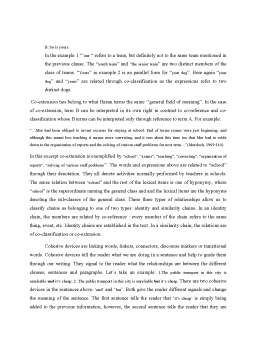Extras din referat
First of all, Cohesion is the ``glue`` that holds the paragraph together. In other words, if a paragraph has good cohesion, then we say the ideas flow from one sentence to another smoothly. The end of one sentence is related to the beginning of the next sentence. Cohesion is a vitally important characteristic of good academic writing because it promotes clarity. The sentences and paragraph within an academic text should all be related to one another. It is the job of the writer to make these connections between sentences and paragraphs , as clear as possible.
In the book “Cohesion in English”, the authors M.A.K. Halliday, Ruqaiya Hasan mentioned that:`` the concept of cohesion is a semantic one; it refers to relation of meaning that exist within the text, and that define it as a text.. Cohesion occurs where the interpretation of some element in the discourse is dependent on that of another. The one presupposes the other, in the sense that it cannot be effectively decoded except by recourse to it. When this happens, a relation of cohesion is set up, and the two elements, the presupposing and the presupposed, are thereby as least potentially integrated into a text (M.A.K. Halliday, Ruqaiya Hasan, Cohesion in English, p.4)”. An example to understand better cohesion, could be: Anna always watches movies with me after school. I was always happy when she did. I like Anna. In this example, we make reference to two individuals: ‘’me’’, the author of the sentence and ‘’Anna’’. The pronominal form ‘’she’’ in the second sentence cannot be interpreted in its own right. The reader has to look in the text to be able to interpret it and for, he should look back to ‘’Anna’’ in the first sentence. This interpretation of the reader is made possible by a particular cohesive relationship that links “she” to “Anna”. The two terms are linked through some meaning relation. Cohesive chains and chain interaction are the most interesting constructs in describing cohesion. In his book, Hasan defined a chain as a set of items, each of which is related to the others by semantic relations of co-reference, co-classification, and co-extension ( Holiday& Hasan, 1989, p.73-74).
Co-reference relates two or more items in a cohesive chain because they have the same referent. Using the previous example: the pronoun ‘’she” refers to no other person but the one who has been mentioned previously in the text as ‘’Anna”. Co-classification ties have a different referent, but a relationship of belonging to the same class. Consider the following examples:
1. Frank will join the youth team, but Jack is in the senior one.
2. A: It`s nice, your dog!
B: So is yours.
In the example 1 “’one “ refers to a team, but definitely not to the same team mentioned in the previous clause. The “youth team” and “the senior team” are two distinct members of the class of teams. “Yours” in example 2 is an parallel form for “your dog”. Here again “your dog” and “yours” are related through co-classification as the expressions refer to two distinct dogs.
Co-extension ties belong to what Hasan terms the same ‘’general field of meaning”. In the case of co-extension, term B can be interpreted in its own right in contrast to co-reference and co-classification whose B terms can be interpreted only through reference to term A. For example:
“ Mor had been obliged to invent excuses for staying at school. End of terms exams were just beginning, and although this meant less teaching it means more correcting, and it was about this time too that Mor had to settle down to the organization of reports and the solving of various staff problems for next term ”(Murdoch, 1969:144)
In this excerpt co-extension is exemplified by “school”, “exams”, “teaching”, “correcting”, “organization of reports”, “solving of various staff problems”. The words and expressions above are related to “school” through their denotation. They all denote activities normally performed by teachers in schools. The sense relation between “school” and the rest of the lexical items is one of hyponymy, where “school” is the superordinate naming the general class and and the lexical items are the hyponyms denoting the sub-classes of the general class. These three types of relationships allow us to classify chains as belonging to one of two types: identity and similarity chains. In an identity chain, the members are related by co-reference : every member of the chain refers to the same thing, event, etc. Identity chains are established in the text. In a similarity chain, the relations are of co-classification or co-extension
Bibliografie
Brown, G. and G. Yule. 1993. Discourse Analysis. Cambridge: Cambridge University Press
Dejica Daniel: Cohesion. Note de curs
Gee, J.P. 2005. An Introduction to Discourse Analysis. 2nd edition. London: Routledge
G. D. 1985. An Introduction to Systemic Grammar. London: Longman. Root
M.A.K Halliday, Ruqaya Hasan. 1976. Cohesion in English London:Routledge
Superceanu, R., 2000, Elements of Discourse and Discourse Analysis, Timișoara: orizonturi Universitare
Taboada M. T. 2004 . Building Coherence and Cohesion: Task-oriented Dialogue in English and Spanish. John Benjamins Publishing
https://media.neliti.com/media/publications/61158-EN-an-analysis-of-grammatical-cohesive-devi.pdf
https://www.oposinet.com/temario-de-ingles-secundaria/temario-2-ingles-secundaria/topic-29-discourse-analysis-cohesion-and-coherence-anaphora-and-cataphora-connectors-deixis/
https://www.researchgate.net/publication/303294565_Cohesive_Devices_in_Written_Discourse_A_Discourse_Analysis_of_a_Student%27s_Essay_Writing
https://www.eapfoundation.com/writing/cohesion/
Preview document
Conținut arhivă zip
- Cohesion.docx




















